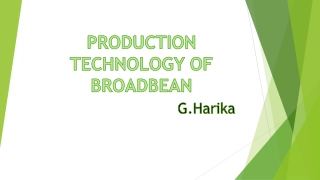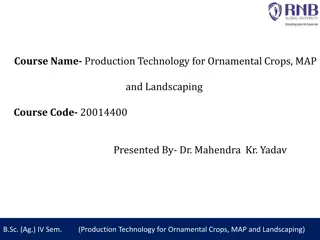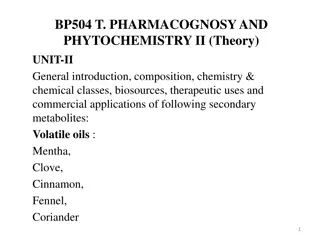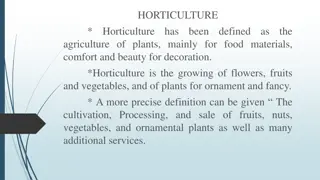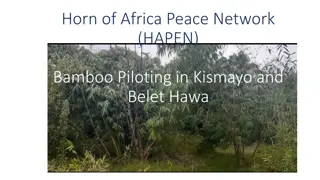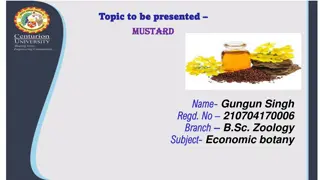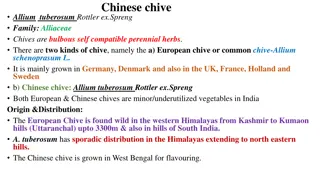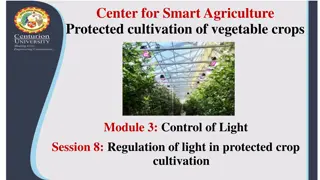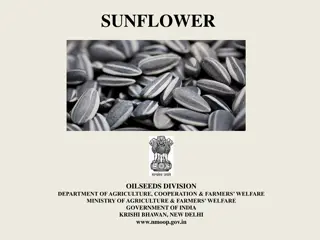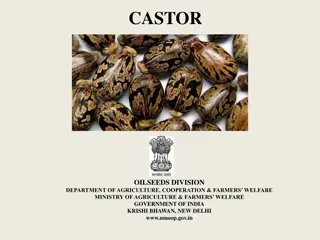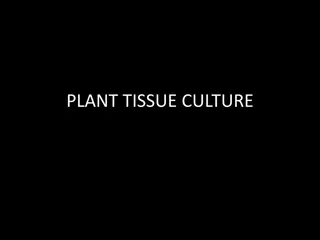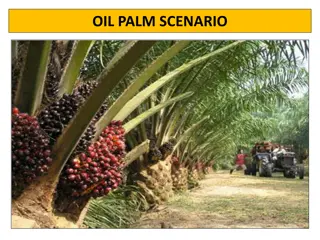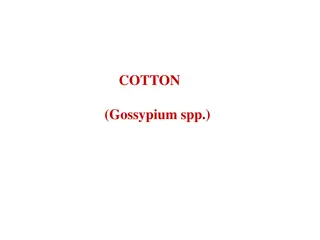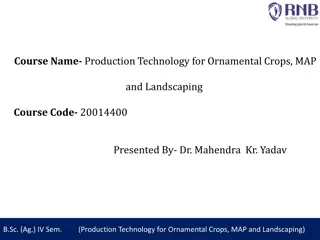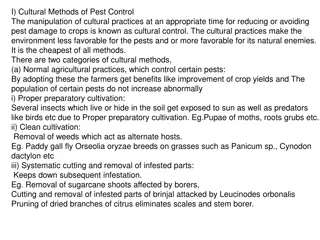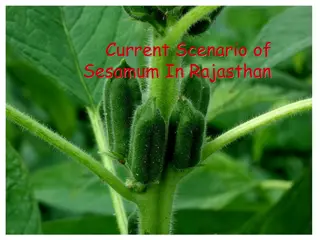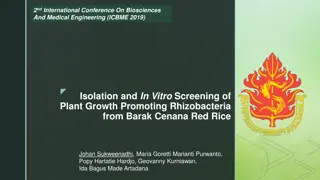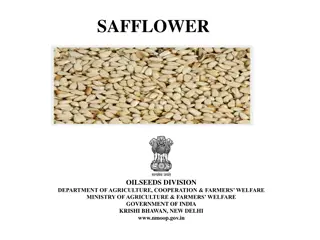PRODUCTION TECHNOLOGY OF BROADBEAN
Broad beans, scientifically known as Vicia faba L., are a valuable crop with significant nutritional value. This article covers the botanical description, nutritive value, cultivation practices, climatic requirements, and more for broad beans. Learn about the plant's growth habits, preferred soil co
1 views • 23 slides
Production Technology for Ornamental Crops and Landscaping: Ashwagandha Cultivation and Benefits
This course covers the production technology for ornamental crops, medicinal and aromatic plants, and landscaping practices. It emphasizes identifying different types of crops, landscaping principles, and the importance of processing and value addition in ornamental crops. Specifically, it explores
0 views • 11 slides
Cultivation and Production of Cinnamon Oil from Cinnamomum zeylanicum
Cinnamon oil, derived from the dried inner bark of Cinnamomum zeylanicum trees, has various uses and applications. This article discusses the cultivation and production process of cinnamon oil, including propagation methods, harvesting techniques, and drying processes to obtain the final product. Wi
0 views • 22 slides
Understanding Horticulture: Cultivation for Food, Beauty, and More
Horticulture involves the cultivation of plants for food, beauty, and various purposes such as decoration and landscape design. It includes the growth of flowers, fruits, vegetables, and ornamental plants, as well as services like plant conservation and landscape restoration. Unlike agriculture, hor
0 views • 10 slides
Understanding Plant Tissue Culture: Methods and Requirements
Plant tissue culture involves the in-vitro culture of plant explants under aseptic conditions, covering cell, organ, and suspension cultures. This process, pioneered by German botanist Gottlieb Haberlandt, relies on the totipotency of plant cells. Key requirements include laboratory organization, su
0 views • 18 slides
Understanding Plant Tissue Culture Media and Their Importance in In Vitro Growth
Plant tissue culture media play a crucial role in the in vitro growth and morphogenesis of plant tissues. The composition of culture media depends on the specific plant species and the type of material used for culture. Various types of media, such as White's medium, MS medium, B5 medium, N6 medium,
0 views • 6 slides
Harnessing Bamboo for Sustainable Agriculture in Somalia
The Horn of Africa Peace Network (HAPEN) is piloting bamboo cultivation in Kismayo and Belet Hawa to combat desertification and promote sustainable agriculture. Bamboo, a versatile plant, offers a renewable resource that can thrive in various climates, including the arid regions of Somalia. The init
0 views • 5 slides
Jute Cultivation in India: A Comprehensive Overview
Jute is a significant natural fiber crop cultivated extensively in India, primarily in the fertile Ganges Delta shared with Bangladesh. This article discusses the cultivation conditions, growth requirements, methods of cultivation, processing techniques, and India's position as a leading jute produc
5 views • 11 slides
Comprehensive Overview of Mustard Plant Cultivation
Mustard, scientifically known as Brassica indica, is a cool-season crop with origins in Europe. India leads in mustard production, with over 150 species primarily found in temperate regions. This versatile plant thrives in different soils and climatic conditions, offering a wide range of cultivation
0 views • 16 slides
Understanding Plant Pathology: Importance, Scope, and Objectives
Plant pathology, also known as phytopathology, is the study of plant diseases and their management. It covers the causes, symptoms, and impact of pathogenic organisms on plants. The field aims to understand the interactions between plants and pathogens, develop control methods, and reduce losses in
0 views • 6 slides
Comprehensive Guide to Chinese Chive (Allium Tuberosum): Botany, Cultivation, and Uses
Chinese chive, a bulbous perennial herb, comes in two varieties - European and Chinese. Originating from the Himalayas and being grown in various regions, it is a minor vegetable in India. Known for its mild garlic-like flavor, chive leaves are rich in nutrients and used in cooking, salad, and tradi
0 views • 7 slides
Regulation of Light in Protected Crop Cultivation: A Comprehensive Overview
Considerations for selecting light sources in greenhouse cultivation include total energy emitted, efficiency, wavelengths, cost, and life expectancy. Options like incandescent, fluorescent, and High Intensity Discharge lamps offer different advantages and efficiencies for supporting plant growth in
0 views • 16 slides
Introduction to Plant Physiology: Exploring the Functioning of Plants
Plant physiology is a crucial subdiscipline of botany that delves into the processes and functions operating within plants. This field closely examines areas like plant morphology, ecology, cell biology, and genetics, shedding light on vital processes such as photosynthesis, respiration, and more. T
1 views • 7 slides
All About Jute: Cultivation, Properties, and Uses
Jute, a versatile fibre plant cultivated in India for over 5000 years, is known for its coarse, strong, and biodegradable fibres. This presentation explores the journey of jute from plant to fabric, emphasizing the importance of cultivation, soil and weather requirements, and top jute-producing stat
0 views • 10 slides
Oil Palm Cultivation and Uses in India: A Comprehensive Overview
Oil palm cultivation in India, particularly in the Oilseeds Division of DAC&FW, is detailed, covering economic aspects, requirements for success, different uses of palm oil, global cultivation statistics, and production trends in major countries. The potential benefits of oil palm cultivation, such
0 views • 31 slides
Understanding Plant Tissue Culture: Techniques and Applications
Plant tissue culture involves maintaining and growing plant cells, tissues, or organs in artificial mediums under controlled conditions. It allows the regeneration of whole plants from small plant parts or cells. Hormones like auxins, cytokinins, and gibberellins are used in the process. Proper envi
3 views • 5 slides
Understanding Catch Crops and Kale Cultivation
Catch crops are fast-growing crops cultivated during fallow periods, offering advantages like providing additional winter fodder and preventing nitrogen leaching. Kale, a popular catch crop, has a biennial growth cycle and various varieties with different characteristics. Factors like soil suitabili
0 views • 17 slides
Sunflower Cultivation: Global Scenario and Production Data
Sunflower cultivation is a significant agricultural activity worldwide, with major producing countries like Russia, Ukraine, China, and India. The plant, scientifically known as Helianthus annuus, thrives in diverse climates and contributes to oilseed production. This summary explores sunflower cult
0 views • 43 slides
Overview of Castor Oilseed Cultivation in India
Castor oilseed cultivation in India is a significant agricultural activity, with detailed information on botanical description, seasonal preferences, global vs. national scenarios, major producing countries, national scenarios, and key growing states. The content sheds light on cultivation practices
0 views • 33 slides
Plant Tissue Culture: Historical Development, Techniques, and Applications
Plant tissue culture is an experimental technique that involves the in-vitro cultivation of plant cells to produce secondary metabolites, regenerate plants, and study organogenesis. This process allows for the maintenance of disease-free plant material, biosynthetic pathway tracing, and cell immobil
0 views • 21 slides
Understanding Plant Tissue Culture: A Brief Introduction
Plant tissue culture involves the in-vitro cultivation of plant cells or tissues under controlled conditions for various applications like the production of metabolites and plant regeneration. This experimental technique facilitates the production of callus from explant tissues, which can be used fo
0 views • 39 slides
Sustainable Cultivation Strategies for EU Crops
This project, funded by the Horizon 2020 Programme, aims to develop sustainable cultivation strategies for various crops in the European Union. Tasks include geographic allocation, trials, sowing strategies, irrigation/fertilisation trials, crop rotation, field tests, and scenarios for raw materials
0 views • 24 slides
Plant Tissue Culture Methods for Growth and Reproduction Study
Plant tissue culture methods such as root tip culture, shoot-tip culture, leaf culture, flower culture, and anther and pollen culture allow for the study of growth, reproduction, and genetic variations in plants. These techniques involve culturing various plant parts under sterile conditions to inve
1 views • 20 slides
The Significance of Jute Cultivation in India's Economy
Jute, a vital commercial fibre crop in India, holds a prominent place in the economy of states like West Bengal, Assam, Bihar, Orissa, and Eastern Uttar Pradesh. It serves as a crucial source of foreign currency earnings and provides employment to millions of farmers and workers. Originating from th
0 views • 28 slides
Understanding Plant Quarantine and Phytosanitary Measures
Plant quarantine involves efforts to prevent the entry, establishment, or spread of foreign pests through legal restrictions on plant and plant product movement. It is crucial for safeguarding plant health, food production, and ecosystems. Phytosanitary measures aim to ensure the health of plants by
0 views • 33 slides
Understanding Mineral Nutrition in Plants
Mineral nutrition in plants involves the acquisition of essential elements in the form of inorganic ions from soil, followed by their absorption and utilization in various plant processes. Around 60 different elements have been reported in plants, with 30 being essential for plant growth. These esse
0 views • 39 slides
Plant Propagation Techniques in Nursery Environment
Learn about plant propagation techniques within a nursery environment, including nursery operations, potting seedlings, plant protection, weed control, packing of nursery plants, and crafting tissues for plant growth. Explore the essential tasks involved in nurturing seedlings and trees before they
0 views • 17 slides
Overview of Oil Palm Cultivation: Yield, Climate, and Major Producing Countries
Oil palm cultivation involves species like Elaeis guineensis and Elaeis oleifera with a cropping period of 25-30 years. The plant is known for its high oil yield per unit area and various uses in food, non-food products, and biofuels. Major growing countries include Indonesia, Malaysia, Nigeria, Tha
0 views • 31 slides
The Importance of Cotton Cultivation in Commercial Agriculture
Cotton, a crucial commercial crop globally, plays a significant role in the economic, political, and social aspects of various countries. Cultivated in tropical and subtropical regions, cotton requires specific climatic conditions for successful growth and yield. The crop season varies across differ
0 views • 24 slides
Production Technology of Periwinkle - Medicinal Plant Cultivation Guide
Learn about the production technology of periwinkle, a perennial ornamental herb with medicinal properties. Understand its botanical details, uses in treating diseases, cultivation requirements such as soil and climate preferences, and its significance in pharmaceuticals. Discover the various alkalo
0 views • 10 slides
Plant Health Initiatives at the 27th Technical Consultation Among Regional Plant Protection Organizations - Memphis, Tennessee
The 27th Technical Consultation in Memphis, Tennessee focused on plant health initiatives by the International Regional Organization for Plant and Animal Health. OIRSA emphasized four key technical areas: plant health, animal health, agricultural quarantine, and food safety. Projects included addres
0 views • 13 slides
Cultural Methods of Pest Control in Agriculture
Cultural methods of pest control in agriculture involve manipulating cultural practices to reduce or avoid pest damage to crops. These practices create an environment less favorable for pests or more favorable for their natural enemies, ultimately improving crop yields and minimizing pest population
0 views • 14 slides
Challenges and Opportunities in Sesamum Cultivation in Rajasthan
The current scenario of Sesamum in Rajasthan reveals fluctuating production and export trends, along with challenges such as low productivity, seed replacement rates, and cultivation constraints. Insect pests and major diseases pose threats to Sesamum crops, while the region showcases varieties like
0 views • 15 slides
Plant Growth Hormones and Defense Mechanisms: Understanding Plant Responses to the Environment
Plant growth hormones and defense mechanisms play crucial roles in how plants respond to environmental stimuli such as water, sunlight, gravity, and more. From auxins promoting cell growth to gibberellins stimulating flowering, this presentation educates on the intricacies of plant hormones and thei
0 views • 13 slides
Isolation and Screening of Plant Growth-Promoting Rhizobacteria from Barak Cenana Red Rice
This research focuses on isolating and screening plant growth-promoting rhizobacteria from Barak Cenana red rice, a local cultivar known for its high anthocyanin and vitamin B content. By studying the potential of these bacterial isolates as microbial inoculants, the aim is to improve the cultivatio
0 views • 20 slides
Understanding Plant Hormones and Their Role in Growth and Development
Plant hormones are vital compounds that regulate various processes in plant growth and development. They are mostly organic and can be gases. These hormones are produced in one part of the plant and transported to other parts where they induce physiological effects. The main phytohormones include Au
0 views • 125 slides
Comprehensive Overview of Soybean Cultivation in India
Soybean cultivation in India, spearheaded by the Soybean Oilseeds Division under the Ministry of Agriculture & Farmers Welfare, Government of India, boasts a rich history tracing back to ancient China. The crop is known for its adaptability to diverse climates and soils, with specific sowing seasons
0 views • 20 slides
Exploring the Fundamentals of Plant Pathology: Understanding Viruses in Plant Diseases
Delve into the world of plant pathology with Mr. Vikash Kumar, as you learn about the nature, structure, and transmission of viruses affecting plants. Explore the important characteristics of plant viruses, their unique properties, and how they interact within plant cells. Gain insights into viral d
0 views • 14 slides
Overview of Plant Quarantine and Disease Management
Plant quarantine is a crucial practice that involves regulating the movement of plants and plant products to prevent the spread of pests and diseases. Originating with the first law in France in 1860, plant quarantine now encompasses various methods such as embargoes and inspections to safeguard pla
0 views • 11 slides
Safflower: Overview of Cultivation, Climate, and Global Scenario
Safflower, scientifically known as Carthamus tinctorius L., is a versatile oilseed crop cultivated in various countries. The plant is characterized by its thistle-like appearance, branching structure, and cross-pollination nature. Safflower is adaptable to different climates, preferring drier areas
0 views • 29 slides
